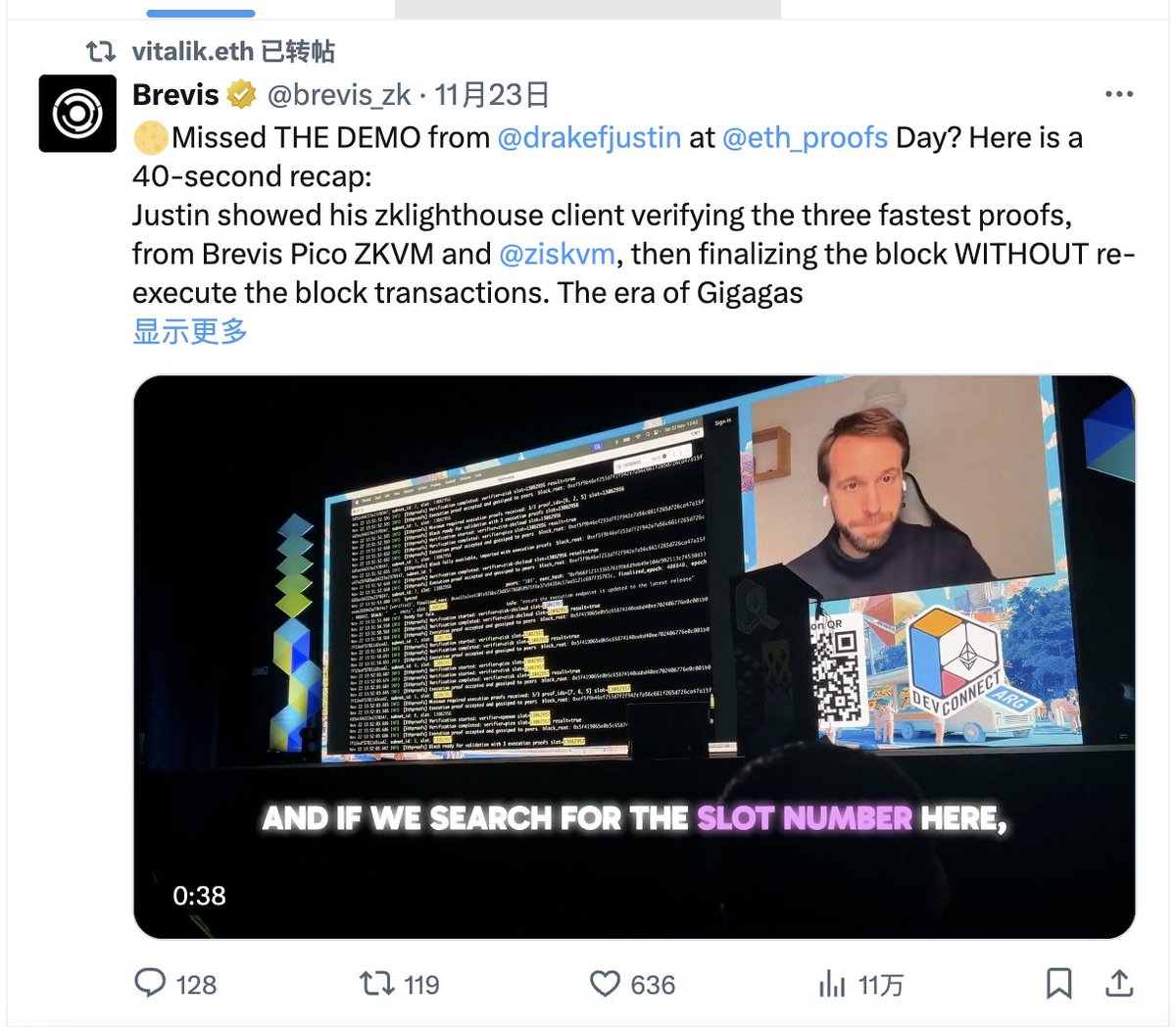Brevis ProverNet|The Next Paradigm Shift in the ZK Track:
@VitalikButerin has once again retweeted brevis @brevis_zk about how to verify the three fastest proofs in Brevis Pico ZKVM and @ziskvm, completing block finality without re-executing block transactions.
In a market that isn't very strong, we must continue to push forward. Just last night, I thoroughly reviewed the ProverNet white paper released by Brevis.
To me, it feels more like a manual for a "paradigm shift":
ZK is transitioning from "competition in proof systems" to "competition in computing power markets"!
1️⃣ First Impression:
The real issue with ZK is not technology, but "computing supply."
The ZK track over the past two years has been very much like the early days of Rollup:
Overall, it has been extremely competitive!
But what is the most realistic thing in the on-chain world?
Supply.
Just like if EVM TPS increases tenfold, it means nothing if no one comes to execute transactions.
What Brevis has accumulated over the past two years is not "performance metrics," but the actual computing demands of real users.
You can tell from its partners: Uniswap v4, PancakeSwap
Euler, MetaMask, Linea, Aave ecosystem;
They have run over 250 million production-level ZK proofs and reached a very "counterintuitive" conclusion: the bottleneck of ZK is not prover performance, but the lack of a computing power that can adapt to all workloads.
I was stunned when I read this.
Because it means: the future of ZK is not "one great prover," but "a diversified computing power market."
2️⃣ Second Impression:
ProverNet seems to have been "forced out" rather than conceived:
The white paper mentions many real workloads:
30-day VIP transaction volume queries (urgent, within 2-3 seconds);
Distribution of rewards to 100,000 addresses (not urgent, but large volume);
zkVM chunk → recursion → merge → wrap → final proof (multi-stage);
Historical data scanning (strong I/O throughput);
When you put these tasks together, you will find: they do not belong to the same type of hardware; different types of provers excel in only a portion of them.
Previously, you might have thought: a wealthy team could just build a GPU farm, but the reality is: one farm cannot cover all ZK workloads;
It's like looking for a delivery platform that only does fried chicken, but then asking it to also deliver seafood, barbecue, desserts, and late-night snacks; it simply can't handle it.
So you see, the emergence of ProverNet is not design, but a natural evolution; it is a necessity of the process.
3️⃣ Third Impression:
TODA is the most underrated part of the white paper:
I know many people will skip over "Truthful Online Double Auction (TODA)."
But the reality is:
This thing is the soul of the entire ProverNet.
Why?
Because what you need to create is a "heterogeneous computing market,"
and you need a mechanism:
that can automatically match different provers;
that can ensure real supply and demand;
that can make malicious bidding unprofitable,
and can approach the optimal solution in NP-hard matching problems (the white paper cleverly uses "phantom requesters" to force integer solutions);
This reminds me of the early auctions in MEV and the early incentive curves in liquidity mining—algorithms are actually more important than performance breakthroughs.
Because technological breakthroughs can be caught up with, but market mechanisms belong to "fundamental rules" that can be reused long-term and accumulated across cycles.
4️⃣ Fourth Impression:
Pico Prism makes all of this realistic, rather than idealistic!
I have read this part several times.
The white paper states it very plainly, but the data is substantial:
99.6% of Ethereum L1 blocks (45M gas) can be proven in 12 seconds
96.8% are completed within 10 seconds, with an average of 6.9 seconds;
using 64×RTX 5090 (consumer-grade hardware).
This means: "real-time proof" is no longer a concept, but a reality.
Why is this important?
Because once ZK proofs can achieve "near real-time," you can outsource more on-chain logic to ZK; for example: personalized fees, VIP transactions, DEX loyalty, trustless incentives, smart router execution, multi-chain state synchronization;
This is precisely the demand that ProverNet aims to meet. Performance breakthroughs are the foundation, while market mechanisms are the superstructure.
5️⃣ Fifth Impression:
Brevis is transforming ZK from "hardcore technology" into "market resources":
There is a line in the white paper that I really like:
ProverNet turns proofs from "internal tools" into "publicly tradable commodities."
I have always believed that an important sign of a technology moving from niche to mainstream is that it becomes a market resource rather than an internal capability of a vendor.
GPUs are like this, bandwidth is like this, and computing power is now like this (the story of Nvidia).
The issue with ZK is not "how difficult it is," but "supply is never enough, and costs are always too high." So when I see Brevis say that provers can: stake, take orders, report costs, be auctioned off, be slashed, be rated
and be collaboratively executed by multiple parties for multi-stage tasks;
I realize: is it possible that ZK is no longer just cryptography, but a part of the "computing economic system"?
You can even imagine a future where there are people specifically doing: zkVM provers, STARK aggregators, wrap specialists, GPU-based latency specialists, CPU-based batch specialists;
An ecosystem will naturally grow out of this.
6️⃣ Finally:
This will be one of the main narratives in the ZK track for the next two years!
Because it addresses a fundamental question in the industry: "Who will provide computing power for Web3?"
Rollup solves execution, DA solves storage, ProverNet solves computing! This is an infrastructure layer that "overlays on all chains."
Whoever can succeed will be the next L2, the next EigenLayer.
In a certain sense:
The ZK Prover Market may be the "decentralized AWS" of Web3.
The white paper describes the mechanism, but what I see is: ZK has finally moved from "engineering breakthroughs" to "market era."

免责声明:本文章仅代表作者个人观点,不代表本平台的立场和观点。本文章仅供信息分享,不构成对任何人的任何投资建议。用户与作者之间的任何争议,与本平台无关。如网页中刊载的文章或图片涉及侵权,请提供相关的权利证明和身份证明发送邮件到support@aicoin.com,本平台相关工作人员将会进行核查。




